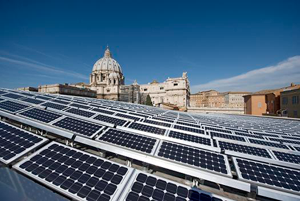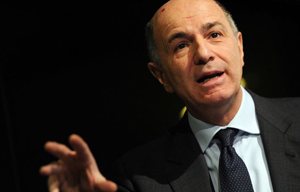Italy finally has an energy plan
on
Italy finally has an energy plan
Italian energy policy is widely seen as suffering from a lack of national planning, but now the country's economic development ministry has set about to change that. It has published a draft version of a new Strategia Energetica Nazionale (SEN), which is out for consultation and comments until the end of the month, and should be finalised by January. "The aim is to provide a clear and a shared vision of the direction for energy," Leonardo Senni, the head of the ministry of economic development's energy department, told European Energy Review. The government wants to continue to promote renewable energy, although it wants to scale down support. It also wants to establish a competitive gas market, reduce import dependence by promoting hydrocarbon production and take decision-making powers away from local governments.
 |
| Solar power in Vatican City (c) SolarWorld |
The country's last energy strategy dates back to 1988 and the general perception is that energy policy has suffered as a result. "Partially due to the fact that there wasn't a common identification of the priorities in energy policy, there have been some non-optimal choices made," Senni believes.
Economically sustainable
A case in point is renewable energy, says Senni, whose booming growth rate in recent years has been very costly. Generous support schemes have encouraged investors to bring on line a large amount of new capacity , particularly in solar photovoltaic power. Italy alone accounted for one-third of new global PV capacity last year. The government notes in its strategic document that incentives for solar and wind power in Italy were higher than in any other European country. Up to January 2012, PV tariffs were roughly double or triple those seen in Germany and France while wind incentives were about 50% higher.
Although the government wants to reduce public support for renewable energy (in fact, it has already done so recently), Senni says one of the main objectives of the new energy strategy is actually to overshoot the 2020 targets for renewable energy and energy efficiency laid down in the government's national renewable energy action plan (NREAP).
If all goes according to the draft plan, Italy will cover 20% of its energy consumption from renewable energy sources in 2020, up from the country's binding 17% target for that year and more than double the 9% level seen in 2010. Renewable energy sources are set to cover as much as 38% of total electricity consumption in 2020 compared to the 26% targeted earlier for that same year. Renewable energy accounted for 22% of electricity supply in 2010.
With all the PV capacity coming online last year, the country is estimated to be very close to its 2020 renewable electricity goal already. Senni points out that according to the scenario laid out in the energy strategy, electricity from renewable sources is expected to at least match and perhaps beat that for electricity from gas-fired power stations. And while Italy initially expected to need imports from non-European Union states to meet its 2020 requirements, that is no longer seen as necessary.
Senni says solar PV is approaching grid parity, the point when it can compete without incentives, and the government anticipates a significant amount of new PV capacity will still be able to come online once the current, and last, round of incentives comes to an end. In its energy strategy, the government foresees it could support PV in other ways, including tax breaks and a further streamlining of bureaucracy.
The fact that a large portion of existing renewable capacity will exit support systems also means that a significant amount of financing should be available post-2015 to support non-PV renewable capacity, says Senni. The idea is that the same financial resources will now allow more capacity to be brought online than in the past, he points out, as technology and the per unit incentive costs have come down.
Although Italy is already in a strong position in terms of energy efficiency, the strategy makes energy efficiency its first priority and targets a reduction of energy consumption of 24% by 2020 compared to a business-as-usual scenario, above the 20% reduction Italy now forecasts. The country hopes to carve out a leadership role in the sector. Some of the ways Italy plans to tackle energy efficiency are by strengthening standards and enforcement, bolstering trading of energy efficiency certificates, extending and fine-tuning tax breaks to help fund energy efficient measures carried out by households and the services sector and providing financial support for research and innovation. Along the way, Italy aims to slightly overshoot its existing targets for C02 emission reductions.
Foreign imports
Senni says these new renewable and environmental goals are seen as one of the two main objectives of the energy plan, along that of gradually bringing Italian wholesale prices for electricity, gas and fuel
| The gas market must be more competitive and also more integrated with Europe, not having only a role of importer but also for the transit of gas |
In the next eight years - the principal time frame of the strategic document - Italy also aims to reduce its dependency on foreign imports. The plan is to reduce foreign energy imports to 67% of the total energy pie from a current 84%, paving the way for estimated annual savings of roughly €14 billion. To help do that, Italy plans to ramp up domestic hydrocarbon production, which has fallen significantly over the last decade. The strategy foresees increasing annual domestic oil production by 57 million barrels of oil to 95 million barrels per year and gas production by 24 million barrels of oil equivalent (boe) per year to 75 million. This would allow Italy to cover 14% of its energy needs compared to 7% now and to save roughly 5 billion euros on the annual energy bill.
"Italy is very much import-dependent and that won't change," says Senni, "but on the other hand, the countries on the North Sea aside, we are among continental European countries with the most important resources. We believe we have an obligation to concentrate on those sites where the environmental impact is limited and it is possible to produce a significant amount."
Potential hydrocarbon resources are placed at around 5.1 billion boe, although the strategy indicates the figure may be higher since exploration activity has also fallen sharply over the last decade. This is equivalent to about 55 times annual Italian production in 2011 and five times Italy's total oil and gas consumption that year. Proved reserves, however, are placed at just 902 million boe.
Another key objective of the energy strategy is the development of a competitive gas market and the establishment of Italy as a gas hub for Southern Europe. "The gas market must be more competitive and also more integrated with Europe, not having only a role of importer but also for the transit of gas," says Senni. "This will help align Italian gas prices to European ones and will also help reduce the differential (over average European prices) for electricity, since gas is the price maker in the market."
The development of the electricity grid to remove bottlenecks and greater European market integration are also expected to contribute to bringing down Italian consumer and industrial energy bills.
National primacy
Senni says one issue that mustn't be overlooked is the need to improve governance in the energy sector at all levels. "Important decisions affecting the energy sector are
| Important decisions affecting the energy sector are increasingly made at European and other international levels and Italy isn't sufficiently represented |
Italy's government also wants to affirm the principle that it is the national government, and not the country's 20 regions and numerous local authorities, that hold primary responsible for energy policy. "It is an area where the field of action is national and multi-national," says Senni. "But you go to a meeting on the pipeline that will transport national gas from the Caspian Sea via Greece and Albania to southern Italy and you find representatives from the countries involved and then there's (southern Italian region) Puglia, which has the same power."
Italy's national government is clearly already attempting to assert its role. Economic legislation approved by the cabinet in October and currently being examined by Italy's parliament includes a measure that would make legislation on the national production, transportation and distribution of energy the exclusive responsibility of the state.
 |
| The SEN was pushed for by the current Italian government and economic development minister Corrado Passera in particular (c) alessandromarciano.com |
In the forefront
As the consultation process continues, comments have been piling in. While energy experts may disagree on specific policy choices or forecasts contained in the strategy document, most who have scoured the 114 pages of the draft energy strategy give the economic development ministry and the Italian government credit for helping to fill a policy void. "It's an industrial policy document and industrial policy is lacking in this country," notes Davide Tabarelli, president of Italian energy think tank and consultancy Nomisma Energia. "It has the great merit of putting energy in the forefront."
| Technically ramping up oil production can be done, but nobody wants this in Italy. There are tons of committees opposed to drilling |
Tabarelli notes that the new energy strategy comes in a context in which Italian policymakers have limited tools. The country can't increase the use of coal to satisfy energy needs for environmental reasons and a 2012 referendum has excluded a return to nuclear power.
Vittorio Chiesa, director of the Energy & Strategy group of Milan's Polytechnic University, believes the energy strategy initiative is "very positive, because it makes up for a multi-decade deficit". He adds that reducing dependence on imports, bringing down energy prices and making energy more sustainable through the greater use of renewable energy and energy efficiency are all objectives that can be shared.
Yet Chiesa stresses that the document's 2020 time horizon is insufficient given the lengthy period required both for energy investments and for calculating returns on those investments. At the least, he suggests the time horizon should be extended until 2030. And while there are lots of numbers in the document, Chiesa says the energy strategy nonetheless lacks a good overview of how the government envisions its overall energy mix and requirements developing over the period, and is a little short on detail. "When you talk about strategy, there are both objectives and actions to get there," he adds. "This document illustrates the objectives for energy policy quite well, but while it cites actions it is a little bit limited when it comes to substantiating them and quantifying their impact."


Discussion (0 comments)